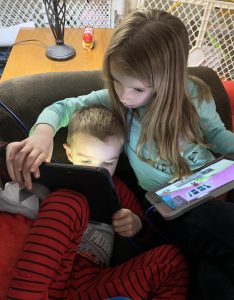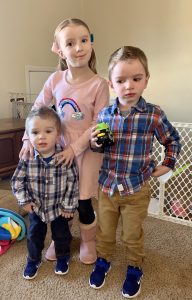An LCA Diagnosis Leads to Founding A Nonprofit for This Family
Even the Covid-19 cloud has a silver lining, and living proof is Andrew Picinich, a 4-year-old preschooler with LCA-CRX, an exceedingly rare form of Leber congenital amaurosis (LCA) caused by a mutation in his CRX gene.
Other than saying a few words, Andrew, who goes by Drew, usually does not speak. Coaxing him to be more open and social poses one of the biggest challenges for his parents.
Turns out being stuck at home in northeast Philadelphia to temper the spread of the coronavirus, opened up Drew’s personality, thanks to being with his family – all day, every day. He is interacting and engaging with them more than ever.
Drew also receives vision teletherapy and virtual preschool assignments through Philadelphia’s Overbrook School for the Blind. Virtual learning, a challenge for many, has its built-in difficulties for a 4-year-old who, as his mother said, has the attention span of, a 4-year-old.
As with many families staying home during the pandemic, the Picinich household is extraordinarily busy. Drew’s mom, 39-year-old Monica, works full time now from home as a teacher of the visually impaired, and Drew’s dad, 41-year-old Cian, works full time downtown for the Philadelphia Corporation for the Aging, which helps with elder care.
Monica, a former middle school science teacher, decided rather than focus on Drew’s pre-Braille and computer skills for now, she would concentrate on teaching him – literally and figuratively – how to navigate everyday life, including helping him learn to play with the same games and toys as his 7-year-old sister, Anna, and 2-year-old brother, Sean. Anna also plays sort of a teaching-assistant role with her outgoing personality. But being so social while not being in a classroom also means she terribly misses her school, and her first-grade friends and her teacher.
CRX: Rare among the rare
At 4 months old, Drew moved his eyes from side to side as if reading a teleprompter, his mom said, and a pediatric

Drew’s Uncle Joe, Grandmom Barbara, cousin Sienna, sister Anna, brother Sean, Drew, Mom Monica, Dad Cian, Aunt Alysha and Uncle Greg, posing with the Easter bunny.
ophthalmologist diagnosed him with nystagmus. At Children’s Hospital of Philadelphia (CHOP), he underwent an electroretinogram (ERG), revealing his LCA diagnosis.
Drew’s confirmed genetic diagnosis later found he had a mutation in his CRX gene, resulting in LCA-CRX, also known as LCA7, a rarer version of the already rare forms of LCA.
The more than 25 identified forms of LCA usually occur in 1 to 2 per 100,000 births. The extremely rare CRX affects 1 percent to 3 percent of all LCA patients.
The CRX mutation also distinguishes itself as an autosomal-dominant gene rather than LCA’s usual autosomal-recessive, meaning a gene mutation caused Drew’s condition, rather than him inheriting it from his parents. This also means Drew has a 50/50 chance of passing it on to his children.
Developing therapies for treating CRX also presents bigger challenges. The CRX dominant gene first needs to be turned off before inserting a good gene. A federally approved therapy for LCA2 (LCA-RPE65) works by inserting a new gene to overtake the bad, while a developing technology of gene editing works like molecular scissors to cut out the mutation.
As part of their search for more CRX information, the family attended the LCA Family Conference hosted by Sofia Sees Hope last summer in Philadelphia. Patients, family members, advocates, doctors, researchers, and biotech industry leaders gathered at the two-day conference.
“I came away with knowledge and connections,” Monica said. “Being able to listen to and converse with doctors, FFB (Foundation Fighting Blindness) representatives, people from Sofia Sees Hope, and other families, was both informative and empowering. Even more impressive was the amount of dedication and love displayed by everyone that attended the conference.”
Drew’s Beacon for Blindness
Soon after their son’s diagnosis, Monica and Cian (pronounced key-in) realized CRX families needed a patient organization to reach other families affected by LCA-CRX and to raise money for research.
Four summers ago, their extended family gathered around the dining room table at Monica’s parents’ beach house. They brainstormed and created Drew’s Beacon for Blindness. Monica and her brother, Joseph Cardullo, run the group.
The nonprofit supports the blind in Pennsylvania, New Jersey, and Delaware, and has two objectives: Finding a treatment/cure for CRX blindness and supporting schools and other organizations that provide educational technology for students living with blindness.
The group secured grant funding to give schools a 3-D printer and a K-NFB Reader (Kurzweil-National Federation of the Blind Reader), a mobile app that converts text to speech or text to Braille.
While researchers work toward developing a treatment for CRX blindness, Monica said, “Our main goal right now is to find other families with the same gene that want to unite to support CRX research.
“Aside from the research, it’s great getting to know people who have similar experiences as you. It helps make your rare experience feel more normal.”
Still in the early planning stages, Drew’s supporters in partnership with the Foundation Fighting Blindness are working on an educational webinar for CRX families. Sofia Sees Hope will help spread the word when the webinar plan comes to fruition.
With more input from researchers and families, Drew’s Beacon for Blindness hopes to discern promising avenues of CRX research and help fund studies to find a cure.
“Hopefully,” Monica said, “We can start to help move the research forward. It would be fantastic if everyone with LCA, no matter the gene, had an option for treatment.”


